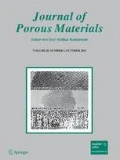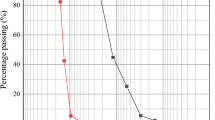Abstract
The durability of concrete structures is often compromised by physical and chemical interaction with the external environment that leads to ongoing maintenance and, in the worst cases, can lead to reduced structural integrity and consequent asset replacement. Concrete is a porous material and most field-exposed concrete is partially saturated with water. Where the concrete is unsaturated and there is no external water pressure acting on a concrete surface, the primary mechanisms of transport into concrete are convective-diffusion ingress (i.e. uptake of water and water-borne agents due to capillary attraction). This paper assesses capillarity and outlines a predictive model of the uptake of water by concrete based on analysis of the pore size distribution. It is acknowledged that concrete has a multitude of internal pores with a broad range of lengths and cross-sectional shapes, surface roughness, tortuosities, random meeting and divergence with adjacent pores, microcracks and fractures, and variable pore-water chemical composition, however the prediction model shows reasonable agreement with water sorptivity test data.





Similar content being viewed by others
References
C. Hall, Build Environ. 12, 117–125 (1977). doi:10.1016/0360-1323(77)90040-3
C. Hall, T.K.-M. Tse, Build Environ. 21(2), 113–118 (1986). doi:10.1016/0360-1323(86)90017-X
P.A. Claisse, H.I. Elsayad, I. G. Shaaban, J. Mater. Civ. Eng. August, 105–110 (1997)
C. Hall, M.H.R. Yau, Build Environ. 22(1), 77–82 (1987). doi:10.1016/0360-1323(87)90044-8z
D.N. Winslow, M.D. Cohen, D.P. Bentz, K.A. Snyder, E.J. Garboczi, Cement Concr. Res. 24(1), 25–37 (1994). doi:10.1016/0008-8846(94)90079-5
B.J. Lampacher, G.E. Blight, J. Mater. Civ. Eng. February, 21–25 (1998)
K.I. Hazrati, L. Pel, J. Marchand, K. Kopinga, M. Pigeon. Mater. Struct. 35, 614–622 (2002)
L.J. Parrott, Cement Concr. Res. 22, 1077–1088 (1992). doi:10.1016/0008-8846(92)90038-W
S. Chatterji, Cement Concr. Compos. 26, 75–79 (2004). doi:10.1016/S0958-9465(02)00124-5
C. Hall, Mag. Concr. Res. 41(147), 51–61 (1989)
G. Ye, Cement Concr. Res. 35, 167–176 (2005). doi:10.1016/j.cemconres.2004.07.033
N. Neithalath, ACI Mater. J. 103(3), 209–217 (2006)
J. Kodikara, M. Whitewhick, P.G. Ranjith, Aust. Geomech. 41(3), 115–131 (2006)
L. Hanzic, R. Ilic, Cement Concr. Res. 33, 1385–1388 (2003). doi:10.1016/S0008-8846(03)00070-X
T. Young, Philos. Trans. R. Soc. Lond. 95, 65 (1805)
E.W. Washburn, Phys. Rev. 18(3), 273–283 (1921). doi:10.1103/PhysRev.17.273
H.-J. Butt, K. Graf, M. Kappl, Physics and Chemistry of Interfaces (Wiley-VCH Verlag & Co., 1993), pp. 118–144
D. Myers, Surfaces, Interfaces, and Colloids: Principles and Applications, 2nd edn. (Wiley, Drew, 1999), pp. 97–124
J.R. Philip, Soil Sci. 84, 257–264 (1957)
P.B. Bamforth, D.C. Pocock, P.C. Robery, Proceedings of International Conference on Our World Concrete and Structures, Singapore, 27–28 August 1985, pp. 1–33
D. Shi, D.N. Winslow, Cement Concr. Res. 15, 645–654 (1985). doi:10.1016/0008-8846(85)90064-X
Acknowledgements
The financial support for this project is jointly provided by Independent Cement and Lime Pty Ltd., Blue Circle Southern Cement Ltd., and Australian Steel Mill Services. The authors thank the sponsors especially Alan Dow, Tom Wauer, Katherine Turner, Paul Ratcliff, John Ashby, and Dr. Ihor Hinczak for the guidance and support. The enthusiatic participation of final year students Soon Keat Lim and Eric Tan in this project is very much appreciated. The efforts and assistance with the laboratory work provided by Jeff Doddrell, Roger Doulis, and Peter Dunbar are also gratefully acknowledged.
Author information
Authors and Affiliations
Corresponding author
Rights and permissions
About this article
Cite this article
Collins, F., Sanjayan, J. Prediction of convective transport within unsaturated concrete utilizing pore size distribution data. J Porous Mater 16, 651–656 (2009). https://doi.org/10.1007/s10934-008-9245-4
Received:
Accepted:
Published:
Issue Date:
DOI: https://doi.org/10.1007/s10934-008-9245-4




